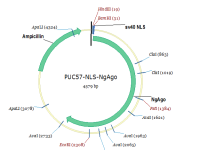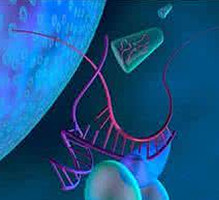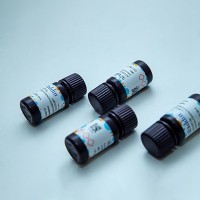RNA干扰(RNA interference,RNAi)综述
互联网
本文由 生物 秀根据华西医学中心微 生物 学教研室ZYH的课件编辑而成
RNA 干扰(RNA interference,RNAi)
RNAi是与靶基因序列同源的双链RNA(dsRNA)所诱导的一种特异性基因沉默现象。它是真核生物中存在的一种抗病毒入侵、抑制转座子活动、调控基因表达的监控机制,具有重大生物学意义。
RNAi的发现简史
90年代初,Rich Jorgensen 设想,将更多的色素基因注入植物体,能使花朵的色彩更艳丽,而结果出其预料,转基因的植株不仅没有新基因表达,反而使原有的色素基因也受到了抑制,当时称共抑制(cosuppression)。
94年Cogoni等证明真菌中亦有类似现象,此称为基因压制 (quelling)。
95年Guo和kemphues在秀丽线虫(C.elegans)中用反义RNA 阻止一些基因的表达,给对照组用正义RNA不但不增加该基因的表达,反而产生与反义RNA 同样的结果——特异性阻断该基因的表达,从而正式表明RNA 干扰现象的存在。
Fire等发现将ds RNA注入秀丽线虫可显著抑制特定基因的表达,并证明了Guo和kemphues所发现的正义RNA的基因压制作用其实是转录时污染微量dsRNA所造成的。
将制备的RNA高度纯化后发现,正义RNA无基因抑制作用,反义RNA的基因抑制作用也很微弱,而用纯化后的dsRNA注入线虫,却能高效、特异地阻断相应基因的表达。实验证明双链RNA抑制基因的表达的效率比纯化后的反义RNA至少高几个数量 ,他们称此现象为ds RNA介导的RNA干扰(RNAi)。图示
Effects of mex-3 RNA interference on levels of the endogenous mRNA. Nomarski DIC micrographs show in situ
hybridization of 4-cell stage embryos.
(A) Negative control showing lack of staining in the absence of the hybridization probe. (B) Embryo from uninjected parent showing normal pattern of endogenous mex-3 RNA (purple staining). (C) Embryo from parent injected with purified mex-3
antisense RNA. These embryos (and the parent animals) retain mex-3
mRNA, although levels may be somewhat less than wild type. (D) Late 4-cell stage embryo from a parent injected with dsRNA corresponding to mex-3
; no mex-3
RNA is detected. (Templates used for interfering RNA and in situ probes were largely non-overlapping.)
RNAi现象的普遍性
随后陆续发现RNAi也存在于水稻、烟草、果蝇、小鼠及人等几乎所有的真核生物中。
RNAi能高效特异的阻断基因的表达,在线虫,果蝇体内,RNAi能达到基因敲除的效果。





